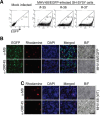A gammaherpesvirus establishes persistent infection in neuroblastoma cells
- PMID: 25092213
- PMCID: PMC4132303
- DOI: 10.14348/molcells.2014.0024
A gammaherpesvirus establishes persistent infection in neuroblastoma cells
Abstract
Gammaherpesvirus (γHV) infection of the central nervous system (CNS) has been implicated in diverse neurological diseases, and murine γHV-68 (MHV-68) is known to persist in the brain after cerebral infection. The underlying molecular mechanisms of persistency of virus in the brain are poorly understood. Here, we characterized a unique pattern of MHV-68 persistent infection in neuroblastoma cells. On infection with MHV-68, both murine and human neuroblastoma cells expressed viral lytic proteins and produced virions. However, the infected cells survived productive infection and could be cultured for multiple passages without affecting their cellular growth. Latent infection as well as productive replication was established in these prolonged cultures, and lytic replication was further increased by treatment with lytic inducers. Our results provide a novel system to study persistent infection of γHVs in vitro following de novo infection and suggest application of MHV-68 as a potential gene transfer vector to the brain.
Keywords: CNS; gammaherpesvirus; gene delivery; neuroblastoma; persistent infection.
Figures






References
-
- Bossolasco S, Falk KI, Ponzoni M, Ceserani N, Crippa F, Lazzarin A, Linde A, Cinque P. Ganciclovir is associated with low or undetectable Epstein-Barr virus DNA load in cerebrospinal fluid of patients with HIV-related primary central nervous system lymphoma. Clin Infect Dis. 2006;42:e21–25. - PubMed
-
- Cho HJ, Yu F, Sun R, Lee D, Song MJ. Lytic induction of Kaposi’s sarcoma-associated herpesvirus in primary effusion lymphoma cells with natural products identified by a cell-based fluorescence moderate-throughput screening. Arch Virol. 2008;153:1517–1525. - PubMed
Publication types
MeSH terms
Substances
LinkOut - more resources
Full Text Sources
Other Literature Sources
Medical

